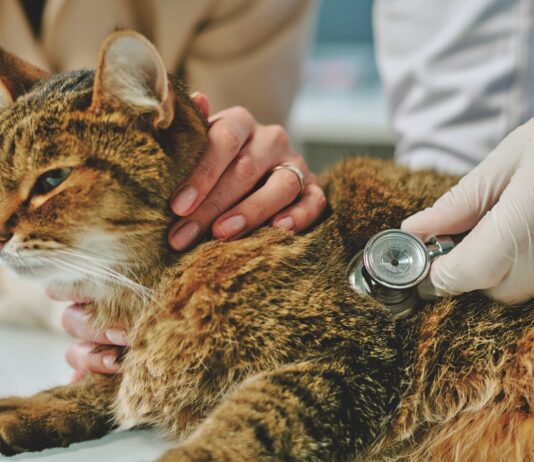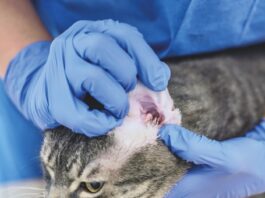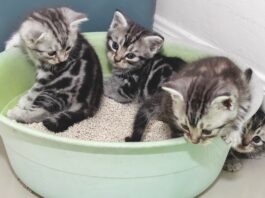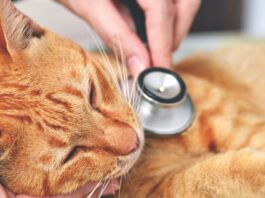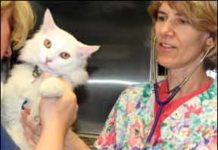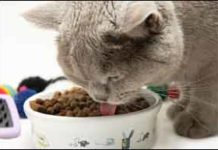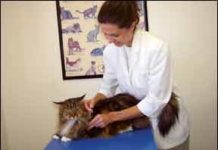Hairballs: Sometimes Serious
Every so often, your otherwise fastidious cat will do this alarming and somewhat disgusting thing. She’ll awake from a peaceful nap, rise up on her paws, retch convulsively for a moment or two, and spit up what may appear at first glance to be a damp clump. What the animal has disgorged — in the middle of your kitchen floor or, worse yet, in the middle of your prized Persian rug — is a trichobezoar, a wad of undigested hair that is commonly referred to as a hairball.Despite the term, disgorged hairballs are not always round. They are often slender and cylindrical, shaped more like a cigar or sausage than a ball.
The Serious Problem of Dental Disease
Red and swollen gums, bad breath, declining appetite and weight loss are among the conspicuous indications that your cat is suffering from a disorder centered in its mouth, most likely in its teeth and gums. The animal may not appear to be in pain, but that’s because cats are generally very good at concealing illness, possibly because they don’t want to signal a potential predator that they are weakened and are thus vulnerable to attack. But a cat with dental disease is likely experiencing significant discomfort, since the sensory nerves that cause humans to experience dental pain are present in the cat as well. Feline dental problems are not at all uncommon, with approximately 90 percent of all cats experiencing some type of dental disease at one time or another.
Short Takes: August 2011
During the second World Conference on Veterinary Education in Lyons, France, an emphasis was placed on animal welfare and the background on the topic that graduating veterinarians need to achieve regardless of their location and training. “Vets can have a direct impact on the attitudes and behaviors of the general public towards animals as advisers to owners as well as to governments and corporations,” explained Ruth De Vere, head of education at the World Society for the Protection of Animals International (WSPA). “After this conference, where the world’s veterinary elite came together globally, I am hopeful that animal welfare will become an integral part of veterinary training.”
Cataracts: Cats Get Them Too
Cats’ eyes are complex arrangements of delicate structural components that need to operate harmoniously in a normal, healthy animal to enable keen vision. Unfortunately, things sometimes go wrong with one or more of these components as a result of disease, aging, traumatic injury or genetically acquired defects. Cataracts can seriously impair a cat’s vision and even cause blindness. Compared to the frequency of its occurrence in humans and dogs, however, this ocular disorder is rarely seen in cats, says Thomas Kern, DVM, associate professor of ophthalmology at Cornell University’s College of Veterinary Medicine. Nevertheless, all cat owners should be able to recognize the physical and behavioral signs of this disorder and understand the special needs of a visually impaired feline.
Diagnosis: Lungworm Infection
Each year, numerous cats are brought into to veterinary clinics throughout the U.S. showing the telltale signs of respiratory distress: labored breathing, chest constriction, wheezing and coughing. In most cases, the animal will be diagnosed with asthma, a mechanical constriction of the airways, or bronchi, the narrow network of tubes that lead directly from the trachea to the lungs. The narrowing of the airways occurs when a cat’s immune system overreacts to the presence of an allergy-producing substance, such as cigarette smoke, dusty kitty litter or pollen and responds to the presence of the allergen by releasing stimulants that cause a swelling of the tissue (mucous membrane) lining the bronchi. But while asthma is by far the most common cause of feline respiratory difficulty, veterinarians will often refrain from diagnosing it definitively until they have reviewed the results of a microscopic examination of the patient’s feces. Why? Because such a procedure could reveal the presence of lungworms in the animal’s respiratory tract — a situation that would produce asthmalike clinical signs but would require a significantly different approach to treatment.
Ask Elizabeth: August 2011
In the U.S. — as in most of the Northern Hemisphere — rabies is a disease of wildlife which occasionally spills over to infect domestic animals and humans. Infection of our pet cats and dogs occurs when unvaccinated animals come into contact with infected wild animals; vaccination provides an important protection to our pets and makes an effective barrier between wildlife rabies and humans. All warm-blooded animals are susceptible to rabies; however, the virus in a particular geographic area is usually a distinct genetic variant that has adapted to preferentially infect a single dominant reservoir host.
Sensitive Skin and Diet: A Challenge
Nothing can be more frustrating for a cat owner - and annoying to a cat - than skin disorders. Nutritional deficiencies or food hypersensitivity; parasites; fungal, viral and bacterial infections; and environmental allergens can cause problems that range from dry, brittle hair and coat to baldness and open wounds. "Most skin diseases are simple and straightforward," says William Miller, Jr., VMD, professor of dermatology at Cornell Universitys College of Veterinary Medicine, "and common problems such as flea bite allergies, abscesses and ear mites are easily recognized, treated and resolved."
Short Takes: July 2011
Thanks to the development of screening assays and vaccines for FeLV, the prevalence of persistently infected cats has decreased. Recent studies indicate that the FeLV genetic material remains in cats exposed to the virus, though viral replication may not occur. Concern exists that this persistent viral DNA may ultimately contribute to development of lymphoma in cats.
Risk of Vaccine-Associated Sarcomas
Due to the demonstrable effectiveness of vaccines in preventing a wide variety of infectious feline diseases, veterinarians used to recommend that every cat be injected every year with every available vaccine. In the past two decades or so, however, this approach to preventive therapy has come into question for several reasons.Although the vaccine safety and efficacy record is very good overall, it has now become clear that vaccination can sometimes lead to clinical disease. It is remotely possible for vaccines to damage developing fetuses in pregnant cats or to stimulate allergic reactions, and for improperly placed injections to cause severe nerve injury. And although uncommon, vaccines and the equipment used to administer them, if poorly maintained or stored, can become contaminated with infectious agents that can be transmitted by injection.
Epilepsy: Inexplicable and Scary
Whether happily playing with its favorite toy, vigorously pursuing a tiny mouse, or frantically fleeing from a dangerous predator, all of your cats activities rely on the controlled transmission of electrical signals among the billions of nerve cells (neurons) that are jammed into its little brain. In a normal cat, the transmission - or firing - of these signals is well controlled within the central nervous system. These neurons either fire or are inhibited from firing according to an animals shifting needs and desires. In the brains of cats affected with the disorder known as epilepsy, however, this elegant process goes awry.
The Importance of Claw Care
The typical cat will spend up to 18 hours a day sleeping and as much as 50 percent of its waking hours meticulously grooming itself. In addition to persistently licking its coat in order to keep it clean and free of dirt and parasites, the animal will pay special attention to its claws, which serve it well as invaluable tools and, when the need arises, as formidable weapons. "A cat in the wild uses its claws for a wide variety of purposes," says William Miller, VMD, medical director at Cornell Universitys College of Veterinary Medicine.
How to Implement Flea Control
Fleas are parasites that suck blood for their food, leaving small lesions that are similar to those of mosquito bites. "They are more than a skin problem," cautions Williams Miller, Jr., VMD, professor of clinical science at Cornells College of Veterinary Medicine. "They can become a serious health problem." Cats are fastidious groomers, so healthy adult cats will keep the number of fleas on their bodies low. "But if there is a significant number of fleas feeding on the animal, they can cause severe anemia," explains Dr. Miller.

